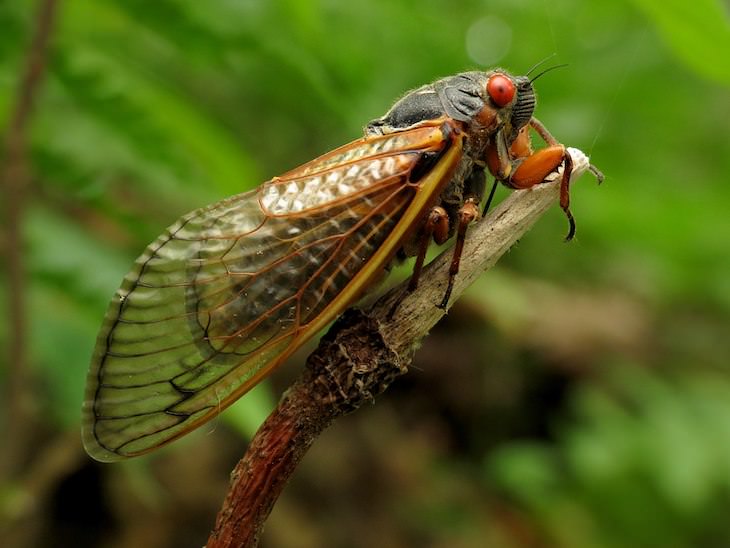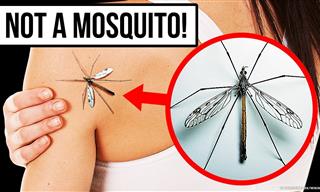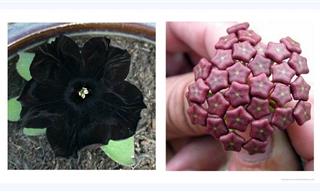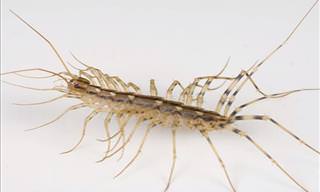
When winter is at its height, it’s hard to think of something set to happen in the spring or summer as very relevant. However, the warmer seasons are only a few months away and experts expect a rare phenomenon to occur in 15 states across the USA this year. For the first time since 2004, millions of cicadas will re-emerge from underground and swarm the country.
The cicada swarm in question is known as Brood X, or the Great Eastern Brood of periodical cicadas. Unlike the more common annual cicadas, which are green, periodical cicadas have black bodies and bright red eyes. Although these insects can look intimidating due to their size (2.5" in length with a 3" wingspan) and ear-piercing buzz, they are mostly harmless.

Image Source: Wikimedia Commons
“The end of May through June, it can get pretty loud – if you are in an area where they are numerous, there can be hundreds of thousands, or millions, of them,” said Howard Russell, an entomologist (insect scientist) at Michigan State University, to USA Today. The states that are expected to see the emergence of the periodical cicadas are Delaware, Georgia, Illinois, Indiana, Kentucky, Maryland, Michigan, North Carolina, New Jersey, New York, Ohio, Pennsylvania, Tennessee, Virginia, West Virginia, as well as Washington, D.C.
The Brood X cicadas emerge en-masse every 17 years when the soil temperatures reach 64 degrees Fahrenheit (18°C), but they can delay their emergence by a few days if the weather is rainy, or otherwise sub-optimal. This time-cycle is one of nature’s great mysteries. Experts are yet to find a definitive answer as to why periodical cicadas aren’t triggered to resurface in, say, the 15th or the 16th spring.
But just because the bugs cannot be seen doesn't mean they are in hibernation. They have been living underground, feeding on sap from tree roots. While living below the surface, the cicadas exist in “nymph” form with white bodies and no wings. It takes about 5 days after their emergence for their exoskeleton to harden and turn black.
The distinctive buzzing noise created by the swarm is due to the male insects trying to attract a mate. After mating, female cicadas will lay eggs in soft, new twigs, using a sharp organ called an ovipositor to cut into the branches and place her fertilized eggs inside. That makes the periodical cicadas quite harmful for tree nurseries and orchards.

“You can’t spray enough pesticide to kill them all without also wiping out everything else in the environment,” Cooley said. What is the solution, then? According to Cooley, it’s putting nets or bags over trees for the period of time the cicadas are active, until around the beginning of July. The eggs hatch in six to ten weeks. The tiny nymphs fall on the ground, burrowing themselves into the soil, and so begins another 17-year cycle.
This is pretty much the only threat the cicadas pose. Their loud buzz may be bothersome, but besides that, they are harmless - they aren’t drawn indoors and they don’t bite.
Apparently, the most common question people have about the cicadas is how to kill them. But Cooley and other experts are urging people to refrain from doing that. "The answer is: don't," he said. "They are one of our natural wonders. Enjoy them while you have them."
Share this information with friends and family!

This Animal Art Is Made Entirely Out of Flowers
This artist uses flowers as his tool and bugs as his inspiration.
 10:19
10:19
Lift Your Spirits With These Animal Rescue Stories!
Forget about the damsel in distress. This time, nature calls, and we must answer!
 9:09
9:09
15 Bizarre Looking Insects and How to Behave Around Them
This video will introduce you to 15 of the most strange-looking bugs in nature, alongside some tips on how to behave around them to stay safe.

16 Majestic Bird Photos That Should Be Framed
The winners of the Bird Photographer of the Year 2022 were recently announced. Let’s check out the best winning images.

Newspaper Headlines Can Sometimes Be Ridiculously Funny
Sometimes newspaper headlines are just so bizarre that you are left scratching your head at what exactly happened.
 8:10
8:10
Winter Hikers, Gather Round for the Best Tip of the Season
Here's how advanced snow hikers layer clothing in the winter.

7 Surprising Animals That Have The Ability To ‘Fly’
Here's a look at some unique and surprising members of the animal kingdom that have developed the ability to fly through the air.

These Photos Prove Mother Nature Can Be So Creative!
These photos prove that Mother Nature has a creative side.

22 Award-Winning Photos That Capture the Power of Nature
The International Photography Awards has many categories, but today, we will focus on nature, with 22 stunning highlights from the 2020 competition.
 28:12
28:12
A Deep Dive into the Biology of Great White Sharks
Great white sharks are marvels of nature.
 14:17
14:17
Who Needs Superheroes When We Have These Dogs?
Take a look at the extraordinary stories of five remarkable dogs who save lives and stop crimes.

I Bet You've Never Seen Animals Like These Before!
From a pink dolphin to a brown panda, you have probably never seen these weird and rare variations of animals.

This is What Pure Love Looks Like in the Animal Kingdom
This heart-warming photo series proves that the love between a parent and child is universal.

10 Beautiful Horse Breeds Everyone Needs to Know About
We humans owe horses so much thanks to the role they've played in human history. These are probably the 10 most interesting breeds of all.

Is Your Dog a Genius? Find Out Now with These 12 Signs!
Ever thought that your dog's a genius? Now You can check with these 12 signs of developed intelligence!

These 20 Animal Facts will Blow Your Mind
Did you know that squirrels plant trees or that oysters can change their gender? These little-known animal facts will blow your mind! I was especially impressed with no.6!
 8:33
8:33
Just How Clever Are Wild Parrots? See For Yourself!
Just how clever a wild cockatoo parrots? This man created a puzzle with seeds in it to see if they could solve it, and here's the footage...

These Transformations from Summer to Winter Will Amaze You
These stunning photographs show some of the world's most beautiful places before and after the arrival of winter. Check them out, you won't be disappointed!
 14:43
14:43
Journey into the Lion Kingdom With Their Fiercest Protector
An amazing video that takes you for a closer look at the heart of the lion kingdom.

Roses Are Even More Beautiful After Reading These 10 Facts
The rose evokes sentiments of love, romance and relationships, but there are some things about them that I never even imagined. Read these impressive rose facts

Think You know the Grand Canyon? Check Out These 12 Facts
It’s one of the natural wonders of the world, and for good reason. Take a look at these 12 facts about the Grand Canyon you might have missed.

Ocean Photographer of the Year 2024: 18 Winning Pics
Marvel at the best winning shots from the Ocean Photographer of the Year 2024.

15 of the Weirdest Creatures from Around the World
Our world is inhabited by some truly bizarre and rare animals you have probably never seen before. Take a look at few such creatures.

20 Beautiful and Exotic Dog Breeds I'd Love to Get to Know!
Here you can enjoy our collection of 20 beautiful photos of exotic and very rare dogs you won't find at your local park.

Discover the World of Powerful Big Cat Hybrids
There are types of big cats you've never heard about, and they're big. beautiful and powerful! Below are photos along some information about these big cat hybrids.
 4:35
4:35
How Cats See The World: A Brief History of Civilization
Have you ever wondered how cats became our pets? In no time, they've grown into our best friends and did some pretty amazing things for humans…

There are So Many Reasons for Us to Love Penguins
Penguins are as beautiful as they are fascinating. Here is all you need to know about these wonderful birds...

There Are Awesome New Dog Breeds in the World...
21 of the most adorable new canine cross breeds.

Spectacular Winners of the 2024 Audubon Photography Awards
Meet the spectacular winners of the 2024 Audubon Photography Awards.
 2:48
2:48
The First 3 Months of a Panda's Life is Amazing to Watch!
The first 100 days in a panda's life. They don't start out looking like pandas!

18 Gorgeous Fish You've Got to See!
The oceans hold countless amazing creatures, such as these 30 fish considered the most beautiful in the world...

The MOST Fascinating Facts About Colors I’ve Ever Heard!
Colors are ubiquitous, and yet we know surprisingly little about them. Let's fix that by learning these 15 fascinating facts about color

The 8 Most Beautiful Bulbs to Plant in Spring
Here are the best spring flowering bulbs for your garden.

16 Fascinating Plants You Have to See to Believe!
How many of these interesting plants have you seen before?

These Natural Wonders Are Too Strange For Words
Natural weather processes have resulted in some truly weird and wonderful natural wonders forming in certain areas of the world. Here are 12 of the weirdest.
 5:35
5:35
Stop Killing Centipedes in Your Home! Here's Why...
When it comes to common house centipedes, it many be far more beneficial for you to simply leave them alone instead of killing them. Here's why.

You Won't Believe the Equine Wonder in These Horse Photos
Wiebke Haas captures some of the world's most beautiful horses strutting their proud stuff in this superb collection of equine majesty.

I Never Thought Such Animals Existed. Wow.
Nature can be beautiful, but it can also be rather strange, especially when you see THESE animals. Most of them are endangered animals, living only in the smallest and most remote places on earth.
 1:30
1:30
This Fish’s Bite is Faster Than Your Blink
This is probably the weirdest fish you will ever see.

These Ancient Trees Stand Ageless and Beautiful
It's incredible to see these living breathing fossils that have been around for centuries. Take a look at these 10 ancient trees.

16 Bizarre Facts That Are So Strange They Could Only Be True
Sometimes science is so bizarre it blows the mind. Read These 16 fascinating facts that prove that truth is stranger than fiction.
 4:28
4:28
Meet the Giant Cassowary – The Modern-Day Dinosaur
Meet the most dangerous bird on Earth, the giant cassowary, that is also regarded as a modern-day dinosaur.

Beautiful! The Color of a Rose Conveys a Special Message
Roses are the most well known and celebrated flower in the world. You may be surprised to discover the meaning of roses and their various colors.

Beautiful: How Your Dog Sees You Vs. How You See Yourself
Although we can feel down in the dumps about ourselves sometimes, our dogs will always keep their faith in us and see us as their heroes.

15 Things You Never Knew About the Panda Bear
When you hear about pandas, you think big, cute and cuddly, but there is much you might not know about these gentle giants...

We Bet You Don't Know How Your Favorite Foods Are Grown!
Ever wondered how peanuts grow? Or what cocoa actually looked like before it was harvested? Well, you've come to the right place!


